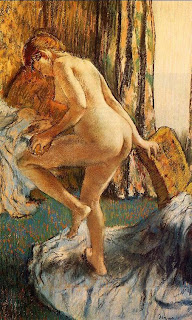 |
| Degas' After the Bath c 1883 |
by Catherine Schofield Sezgin, ARCA Blog Editor-in-Chief
B. A. Shapiro's The Art Forger (Algonquin Books, 2012) mixes elements with the 1990 theft of the Isabella Stewart Gardner Theft with the Boston art world and art forgery. Ms. Shapiro uses a fictional painting by Edgar Degas, After the Bath, in this art crime novel.
Here's a link to the book review in The New York Times by Maxwell Carter, an associate vice president and a specialist in Impressionist and modern art at Christie’s, which provides a nice synopsis of the plot.
Here's a link to the author B. A. Shapiro's website which includes information on art thefts, art forgeries, and encouraging words about writing novels.
This link to a book review last January in the Salisbury Post ("'Art Forger' leaves readers wondering what's real") highlights the author's note at the end of the book:
Shapiro does several clever things. She uses real artists and real connoisseurs like Gardner in the telling of the book. All the forgers Claire learns from are real, as are the techniques they used. She mixes in chapters of Isabella Gardner’s letters to her niece detailing her adventures with Degas — these are juicy fiction. She offers “A Note on the Research” at the end of the book to make clear what is history and what is fiction.
Barbara Shapiro writes in this "Note on the Research":
The painting techniques that Claire uses for both her forgery and her own work are consistent with current practices, as are the descriptions of the struggles of a young artists. The forgers and dealers she discovers through her Internet research were/are actual people, including John Myratt, Ely Sakhai, and Han van Meegeren, and the specifics of their crimes, methods, inventions, and punishments are also accurate.
The details of the 1990 robbery of Gardner Museum are factual -- it remains the largest unsolved art heist in history -- with the exception of the inclusion of Degas' fifth After the Bath, which neither was stolen nor exists, although it is a composite based on his other four After the Bath works.

Reading this book now and really enjoying the juxtaposition of the current day life of the artist and trying to hold together heart and home. The letters from Aunt Belle mixed with discussion of the social scene in 1886 make this time come to life. I’m going to enjoy the next impressionist exhibition, or going to a local SF museum!
ReplyDelete